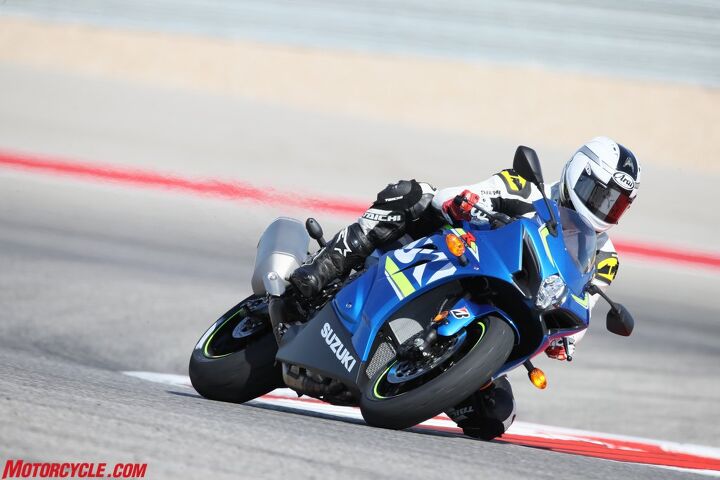By now you should know quite a bit about the new, 2017 Suzuki GSX-R1000 (and, by extension, the GSX-R1000R), since we’ve written a lot about them lately. We’ve gone over technical details and riding impressions mainly, and while those are obviously the most timely and important things people want to know about the bike, we’ve got even more nuggets of information about the new GSX-R, learned from the recent U.S. press introduction of the standard model the Monday following the U.S. Grand Prix at the Circuit of the Americas. Factoids, if you will, these little bits of info didn’t really find a home in our First Ride reviews, but we had to share them with you somehow. So, herein are nine things you didn’t know about the 2017 Suzuki GSX-R1000.
1. Shinichi Sahara
Chief engineer for the GSX-R1000, Shinichi Sahara is a former racer. He started his Suzuki career working on the TL1000, then later moved to the Alstare Suzuki World Superbike team, and then eventually to MotoGP, where he helped developed the variable valve timing system now being used on the GSX-R. During the press ride of the Gixxer at COTA I had the chance to ride behind Sahara-san, and I can tell you firsthand that the guy knows how to ride! Unfortunately his enthusiasm got the best of him that day, as a gentle lowside at COTA’s Turn 1 resulted in the only crash of the day. Then again, if anybody were allowed a crash pass on the new Gixxer, it’s only right it’s given to the guy who designed it.
2. The Yoshimura Suzukis Are The single-R GSX-R1000, not RR
The Yoshimura Suzuki squad competing in the MotoAmerica series with riders Roger Hayden and Toni Elias are one of a handful of teams around the world that are getting support direct from the factory. However, Roger and Toni aren’t riding the double-R version of the Gixxer (the GSX-R1000R) – their MotoAmerica Superbikes are based on the single-R GSX-R.
3. Only the U.S. Gets Three Versions
In other markets in the world, Suzuki will provide the GSX-R1000R and GSX-R1000 ABS. However, in America, where we don’t have mandatory ABS regulations, Suzuki is also making available a GSX-R1000 without ABS. The price difference is $400, and Suzuki thinks the non-ABS model will appeal to those who either hate the idea of ABS on their bikes, or want the least expensive literbike on the market today. ABS models are recognizable with an ABS decal on the front fender, and are available in either the red or black colorways seen above. Non-ABS models are also available in red or black, but if you see a GSX-R1000 with the MotoGP-inspired Suzuki livery, then you’ll know you’re looking at a non-ABS model.
4. Lean Angle
In designing the all-new engine for the latest GSX-R, Suzuki not only made it more compact, but also angled it back five degrees compared to its predecessor. This allows for a longer swingarm, which helps provide greater stability, especially under acceleration.
5. More Processing Power
Now that the new GSX-R is equipped with an IMU and the associated electronic rider aids that come with it, the bike needed a much smarter, faster brain. Suzuki accomplished this with a 32-bit dual processor ECM, giving it twice as much computing power as the previous bike.
6. No, Really. It’s Ride-by-Wire
Suzuki did a really clever thing with the GSX-R’s ride-by-wire system. If you look at the throttle, you might be deceived because it looks like a cable-actuated throttle. However, the joke’s on you, as the R-b-W throttle is built like a conventional throttle housing and sleeve, with wires running to spring-loaded cam to provide more natural feel. All the electronics are under the fuel tank, where it’s safer. In the event of a minor tip-over where you mangle the throttle, you’ll just have to replace a relatively cheap throttle tube.
7. Sportbikes Are Still Important To Suzuki
In general, sportbike sales don’t account for a big sum of sales in the overall motorcycle market. However, sportbikes represent 26% of all Suzuki motorcycle retail over the past two years. The GSX-R line still means a lot to Suzuki, and in turn Suzuki remains loyal to it.
8. America Is A Special Place For Suzuki
Tak Hayasaki joined Suzuki in 1981. Today he’s President of Suzuki Motor of America. During his time at Suzuki he’s seen the birth of the GSX-R line and witnessed its success around the world, but especially so in America. Along the way he’s seen the rise of many Americans who have won on Suzuki motorcycles, including none other than Suzuki’s favored son, Kevin Schwantz. To Hayasaki-San, the GSX-R and the U.S. have a special place in his heart. It’s also the reasoning he gives as to why America is the only country that will get a third, non-ABS, version of the GSX-R.
9. Number 34
Kevin Schwantz and Suzuki will always be linked together, which is why Suzuki gifted Kevin a 2017 GSX-R1000 – serial number 34. Schwantz’s Grand Prix career is well known, with the 1993 championship being the crown jewel in his impressive resume, but his history with GSX-Rs is also impressive. He was the first factory rider in America aboard the Yoshimura Suzuki GSX-R750, when the model was introduced in America in 1986. He won six of his nine AMA Superbike victories on Suzuki GSX-Rs (his first three wins were on GS750ES models) including his famous 1988 Daytona 200 win. Schwantz was also the first rider to win an AMA Superbike pole and the first to stand atop an AMA Superbike podium on a GSX-R. His connection to the model, and to Suzuki, is unparalleled and the reason why Suzuki chose to present him with the iconic number 34 bike.
9 Things You Didn’t Know About the 2017 Suzuki GSX-R1000 appeared first on Motorcycle.com.
【Top 10 Malaysia & Singapore Most Beautiful Girls】Have you follow?








